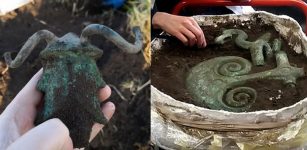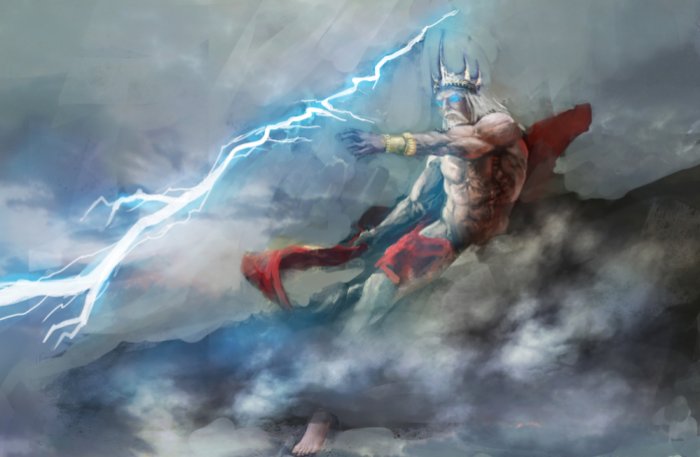The Olympics In Ancient And Modern Times – What Has Changed?
AncientPages.com - The Rio Olympics will be the 31st Summer Games of the modern era, but they have a long way to go before they can compete with nearly 12 centuries of ancient Olympics. Athletes came from across Greece to compete in everything from running to discus to boxing to horse racing, in honour of the Greek god Zeus. The games dated back to 776 BC (and perhaps earlier), and ran at least to the end of the fourth century AD.
Most people probably have a sense of how the ancient games formed a template for the modern Olympics, but when you dig into the detail of the ancient sources you start to see that things are not so simple:
1. Olympic ideals debunked
Many of the claims people have made about connections between the ancient and modern games are false. The Olympics presents itself as a vehicle for world peace and unity, justified by the idea that the so-called ancient Olympic “truce” involved a cessation in fighting across the Greek world during the games. But we now know that it was mainly just for protecting those who travelled to the games.
Hulk who? Drinks Machine, CC BY-SA
Then there is the elitist ideal of Olympic amateurism in the 19th and early 20th centuries. That was justified by the idea that ancient athletes competed just for the sake of it, but it is clear now that they were in it for money.
The history of the triple jump is strangest of all. It was invented for the 1896 Athens Olympics in response to an ancient text recording a long-jump record of more than 15 metres. When you look at the text more closely, it becomes clear that the distance was meant as a joke.
2. Holy cow!
Misleading claims like these have generally been based on a relatively small number of literary texts from the fourth and fifth centuries BC (the classical period). But if you really want to understand ancient sport you need to look also at the thousands of surviving athletic inscriptions carved on stone from the last three centuries BC (the Hellenistic period) and the Roman Empire (from 31BC onwards): few other texts give such a vivid glimpse of ancient day-to-day life.
When you look at that material you realise just how bizarre and alien some aspects of ancient sport were by modern standards, especially the religious element. Imagine cows being sacrificed between races in the middle of a modern Olympic stadium, for instance.
3. Calendar crunching
Yet this material also points us to some surprising similarities between ancient and modern. Many have argued that complex and bureaucratic sporting events were only developed in the 19th century. The evidence from the Roman Empire shows that this can’t possibly be right.
Greek athletics flourished in the Roman Empire and the Olympics in particular underwent a revival, especially through the sponsorship of successive emperors. The Olympics was the lead event in a calendar that involved probably more than 500 independently organised annual festivals across the eastern Mediterranean. The organisational complexity and financial investment were enormous.
4. Construction time again
The media has been full of the usual stories about the race to get Olympic buildings finished in Rio. At least in the ancient world, sports festivals stayed in the same place so buildings could be reused.
Yet preparation was far from straightforward. The following text, dating probably from around 240BC, describes preparations for the Pythian festival (second only to the Olympics). It lists over 40 tasks, each with a large price tag and building contractor:
Digging and levelling the covered practice track and the colonnade … digging and levelling the open-air practice track … provision of 270 medimnoi [about 14,000 litres] of white earth for the covered practice track … fencing of the covered practice track …
Maintenance of the covered and open-air practice tracks, the rooms for ball games, and the gymnasium … cleaning out of the Pythian stadium and renovation of the surrounding embankments … digging of the Pythian stadium, and digging and levelling of the jumping pits … construction of the auditorium.
There is evidence, too, of public-private partnerships, where rich individuals paid for works that would be available for profit-making outside festival time.
Artist’s impression of Ancient Olympiad. Credit: Public Domain
5. Opening ceremonies
The torch relay wasn’t an ancient institution. It was invented by the German classical scholar Carl Diem for the 1936 Olympics in Berlin, and glorified through Leni Riefenstahl’s film Olympia.
The opening ceremony does have some ancient parallels, however. As far as we can tell there was a procession from the city of Elis 30 or 40 miles away. It seems to have included all athletes and umpires, presumably with lots of fans tagging along. It involved stops for ritual purification with pig’s blood along the way.
See also:
Ancient Children Played Marbles Thousands Of Years Ago
Ancient Irish Games Hurling And Curling Were Forbidden In 1366 By The Englishmen
Tailteann Games: Ancient Irish Version Of The Olympic Games
Lacrosse Was Invented By Native American Indians
On arrival in Olympia, the umpires would sort the athletes into age classes, deciding who should compete in the boys’ category and who in the men’s. Then the athletes would swear oaths on slices of wild boar’s flesh in front of the statue of Zeus, promising good conduct.
But possibly a better precedent for the complexity of the modern preliminaries is the ancient tradition of sending out envoys (theoroi) across the Greek world. They would notify other cities of the Olympics and invite them to send ambassadors to celebrate membership of the wider Greek community. They visited dozens of cities, highlighting the festival organisers’ great care to maintain contact around their world. It must have taken many months in all.
6. Whipping into line
We have heard a lot recently about concerns over Brazilian police capabilities. Security mattered at the ancient games too. It’s hard to find parallels for modern terrorism, but ancient crowds could get rowdy. Famously there were riots in Pompeii after a gladiatorial contest in 59AD.
Ancient officials watched out for cheating competitors, but they could also target spectators. They were known most often as “mastigophoroi” or whip-carriers. There is evidence that they wore distinctive uniforms and also carried sticks and shields. We might not quite be ready for Rio security officials with whips, but this concern with public order is another sign that some things have changed less than you might imagine.
Written by Jason König - Professor of Greek, University of St Andrews
This article is republished from The Conversation under a Creative Commons license. Read the original article.
More From Ancient Pages
-
 Precious Ancient Chinese Immortality Suits Made Of Jade
Artifacts | Aug 22, 2015
Precious Ancient Chinese Immortality Suits Made Of Jade
Artifacts | Aug 22, 2015 -
 Beautiful Neolithic Ornate Necklace With Over 2,500 Stones Found In A Child’s Grave
Archaeology | Aug 2, 2023
Beautiful Neolithic Ornate Necklace With Over 2,500 Stones Found In A Child’s Grave
Archaeology | Aug 2, 2023 -
 First Neanderthal Footprints Discovered In Gibraltar Dunes
Archaeology | Feb 14, 2019
First Neanderthal Footprints Discovered In Gibraltar Dunes
Archaeology | Feb 14, 2019 -
 Khufu Boat And Unique Boat-Building Technique Of Ancient Egyptians
Artifacts | Jun 20, 2017
Khufu Boat And Unique Boat-Building Technique Of Ancient Egyptians
Artifacts | Jun 20, 2017 -
 Mysterious Scottish Stone Circles On Orkney Were Used To Something Very Different Than Previously Thought
Archaeology | Sep 24, 2017
Mysterious Scottish Stone Circles On Orkney Were Used To Something Very Different Than Previously Thought
Archaeology | Sep 24, 2017 -
 Ancient Biblical Manuscript M.910 We Are Afraid To Open May Contain A Surprise
Archaeology | Feb 19, 2018
Ancient Biblical Manuscript M.910 We Are Afraid To Open May Contain A Surprise
Archaeology | Feb 19, 2018 -
 On This Day In History: Battle Of Marton, Part Of Viking Invasions Of England Took Place – On Mar 22, 871
News | Mar 22, 2017
On This Day In History: Battle Of Marton, Part Of Viking Invasions Of England Took Place – On Mar 22, 871
News | Mar 22, 2017 -
 Secrets Of Mount Shasta – One Of The Most Sacred Places On Earth
Civilizations | Oct 24, 2015
Secrets Of Mount Shasta – One Of The Most Sacred Places On Earth
Civilizations | Oct 24, 2015 -
 Legendary Lost Island Of Gold Of The Mysteriously Vanished Srivijaya Civilization Found Underwater
Archaeology | Oct 25, 2021
Legendary Lost Island Of Gold Of The Mysteriously Vanished Srivijaya Civilization Found Underwater
Archaeology | Oct 25, 2021 -
 The Thunder Stone: World’s Largest Monolith Moved By Man
Ancient History Facts | Jun 14, 2018
The Thunder Stone: World’s Largest Monolith Moved By Man
Ancient History Facts | Jun 14, 2018 -
 Raven: Uncommonly Intelligent Bird, Symbol Of Providence, Wisdom And Prophecy
Ancient Symbols | Feb 25, 2019
Raven: Uncommonly Intelligent Bird, Symbol Of Providence, Wisdom And Prophecy
Ancient Symbols | Feb 25, 2019 -
 Did Democracy Have A Separate Origin In The Americas?
Archaeology | Jun 15, 2022
Did Democracy Have A Separate Origin In The Americas?
Archaeology | Jun 15, 2022 -
 Mysterious Kallerup’s Double-Headed Figurine – Evidence Of Unknown Norse God Or Worship Of Roman God Janus In Ancient Scandinavia?
Artifacts | Mar 19, 2020
Mysterious Kallerup’s Double-Headed Figurine – Evidence Of Unknown Norse God Or Worship Of Roman God Janus In Ancient Scandinavia?
Artifacts | Mar 19, 2020 -
 Perfectly Preserved 10,500-Year-Old Basket Found In Muraba’at Cave
Archaeology | Mar 18, 2021
Perfectly Preserved 10,500-Year-Old Basket Found In Muraba’at Cave
Archaeology | Mar 18, 2021 -
 Mysterious Gympie Pyramid: Evidence Of An Ancient Lost Civilization In Australia?
Civilizations | Feb 13, 2020
Mysterious Gympie Pyramid: Evidence Of An Ancient Lost Civilization In Australia?
Civilizations | Feb 13, 2020 -
 Hyperborea Or Atlantis Ruins – Underground Secrets Of The Sacred Lake On The Arctic Circle
Civilizations | Nov 17, 2014
Hyperborea Or Atlantis Ruins – Underground Secrets Of The Sacred Lake On The Arctic Circle
Civilizations | Nov 17, 2014 -
 Christmas – One Of Most Celebrated Holidays In Christian Calendar
Ancient Traditions And Customs | Dec 24, 2018
Christmas – One Of Most Celebrated Holidays In Christian Calendar
Ancient Traditions And Customs | Dec 24, 2018 -
 Historic Event – Exeter Museum Returns Ceremonial Dress Of Famous Chief Crowfoot To Canada’s Siksika People
Artifacts | May 20, 2022
Historic Event – Exeter Museum Returns Ceremonial Dress Of Famous Chief Crowfoot To Canada’s Siksika People
Artifacts | May 20, 2022 -
 Utsuro Bune: Ancient Extraterrestrial Encounter With A ‘Hollow Ship’ And An Alien Visitor
Featured Stories | Jun 11, 2020
Utsuro Bune: Ancient Extraterrestrial Encounter With A ‘Hollow Ship’ And An Alien Visitor
Featured Stories | Jun 11, 2020 -
 Lost Medieval Home Of The Lords Of The Isles – Reconstructed Virtually
Archaeology | May 29, 2019
Lost Medieval Home Of The Lords Of The Isles – Reconstructed Virtually
Archaeology | May 29, 2019



